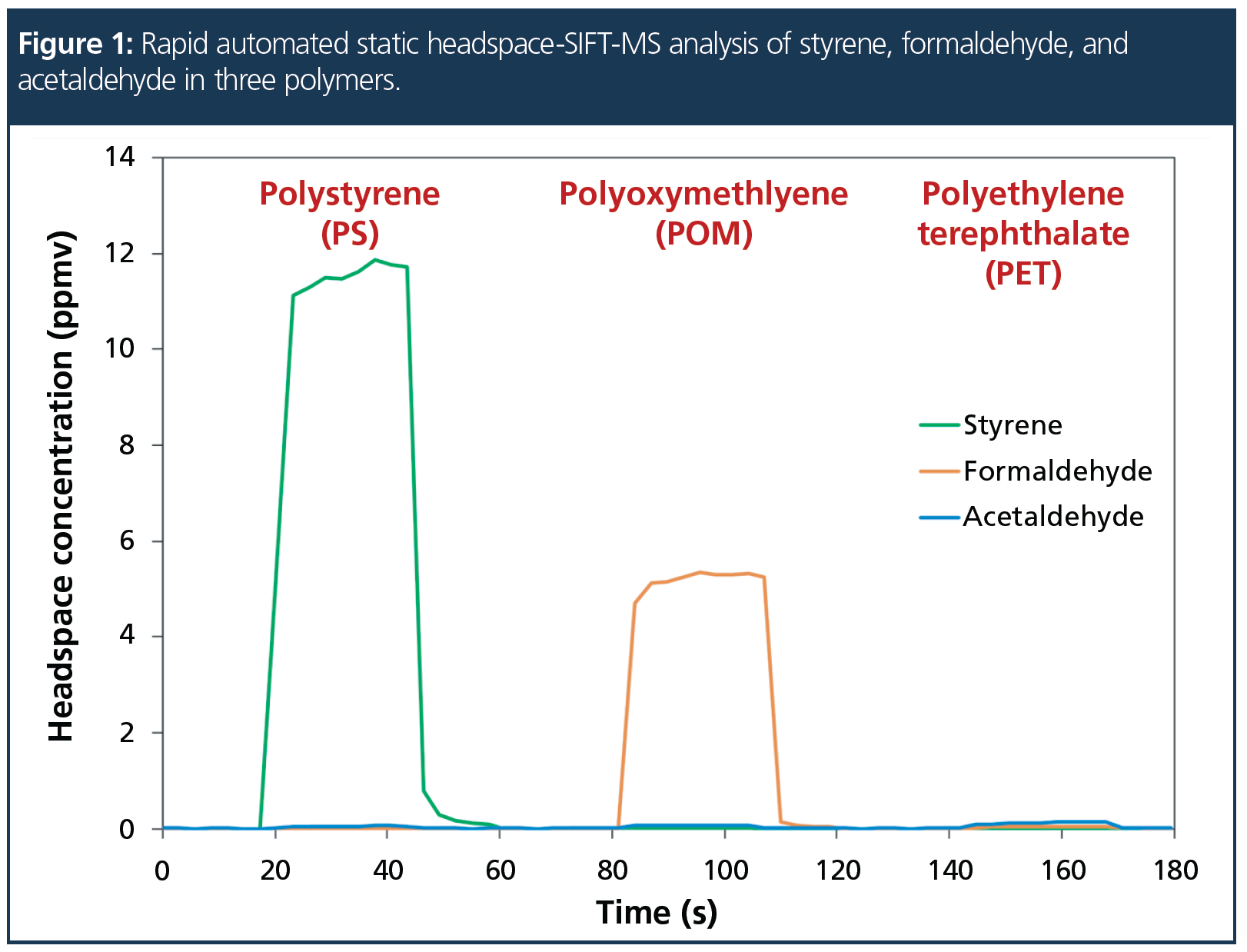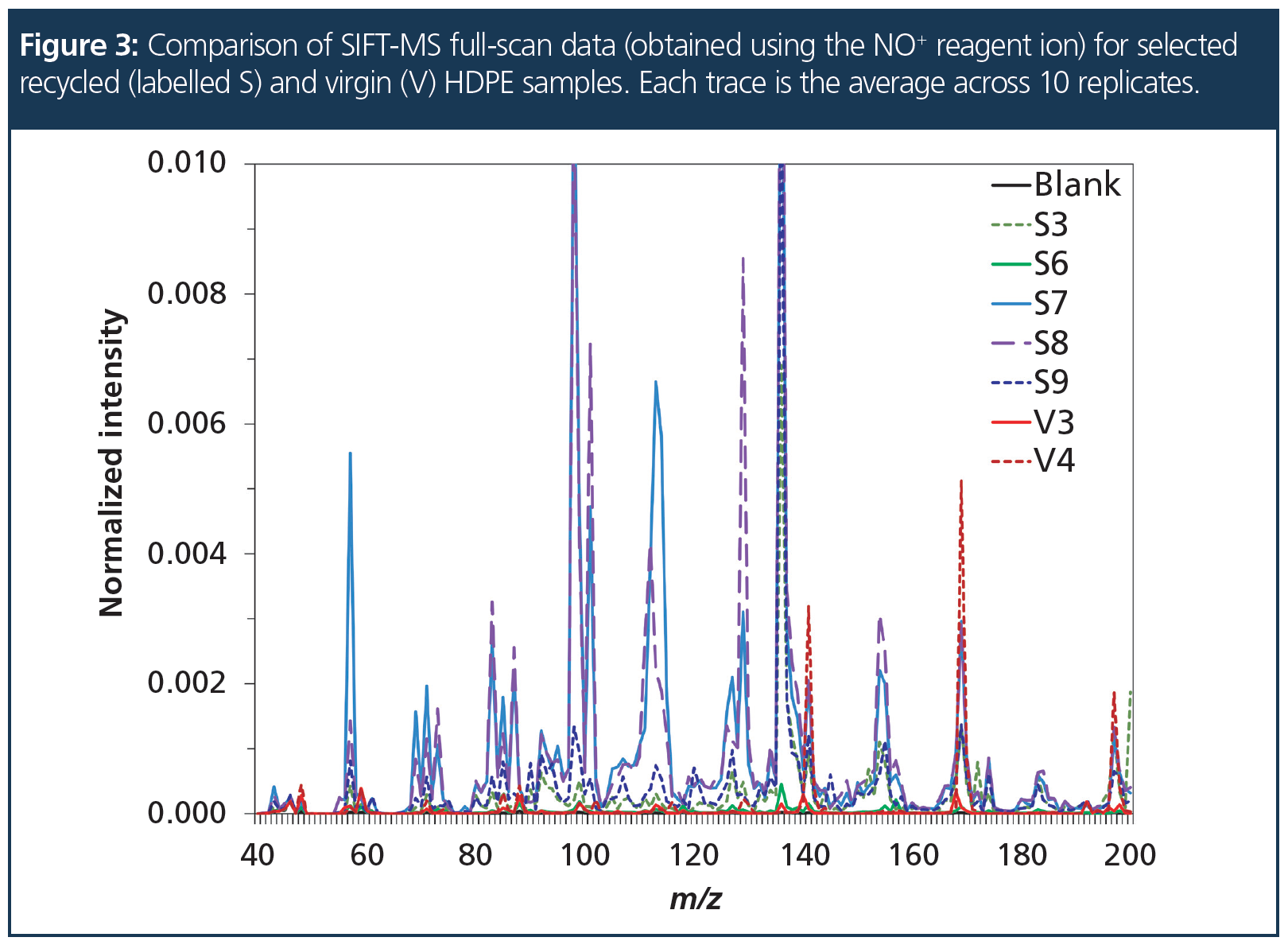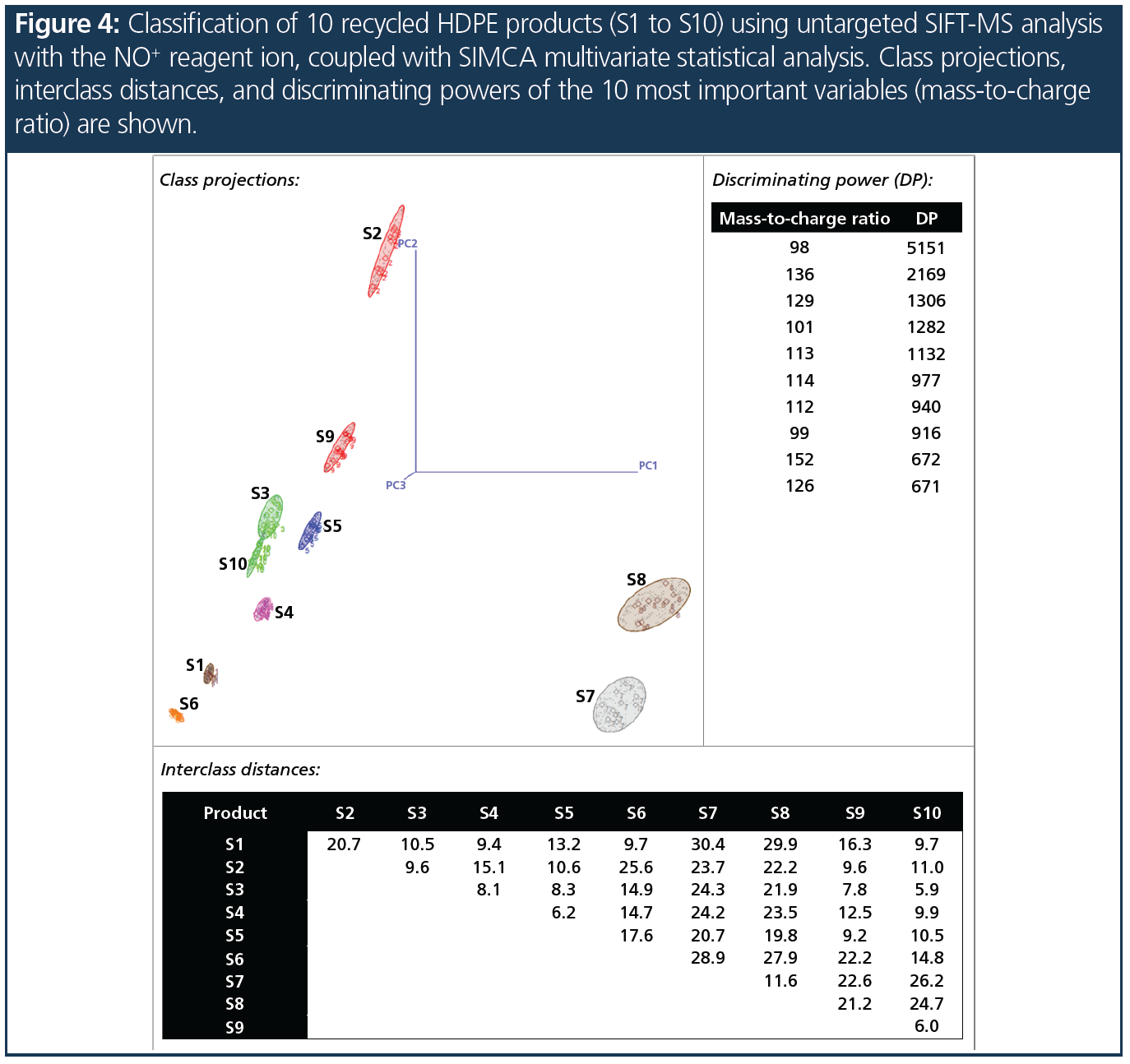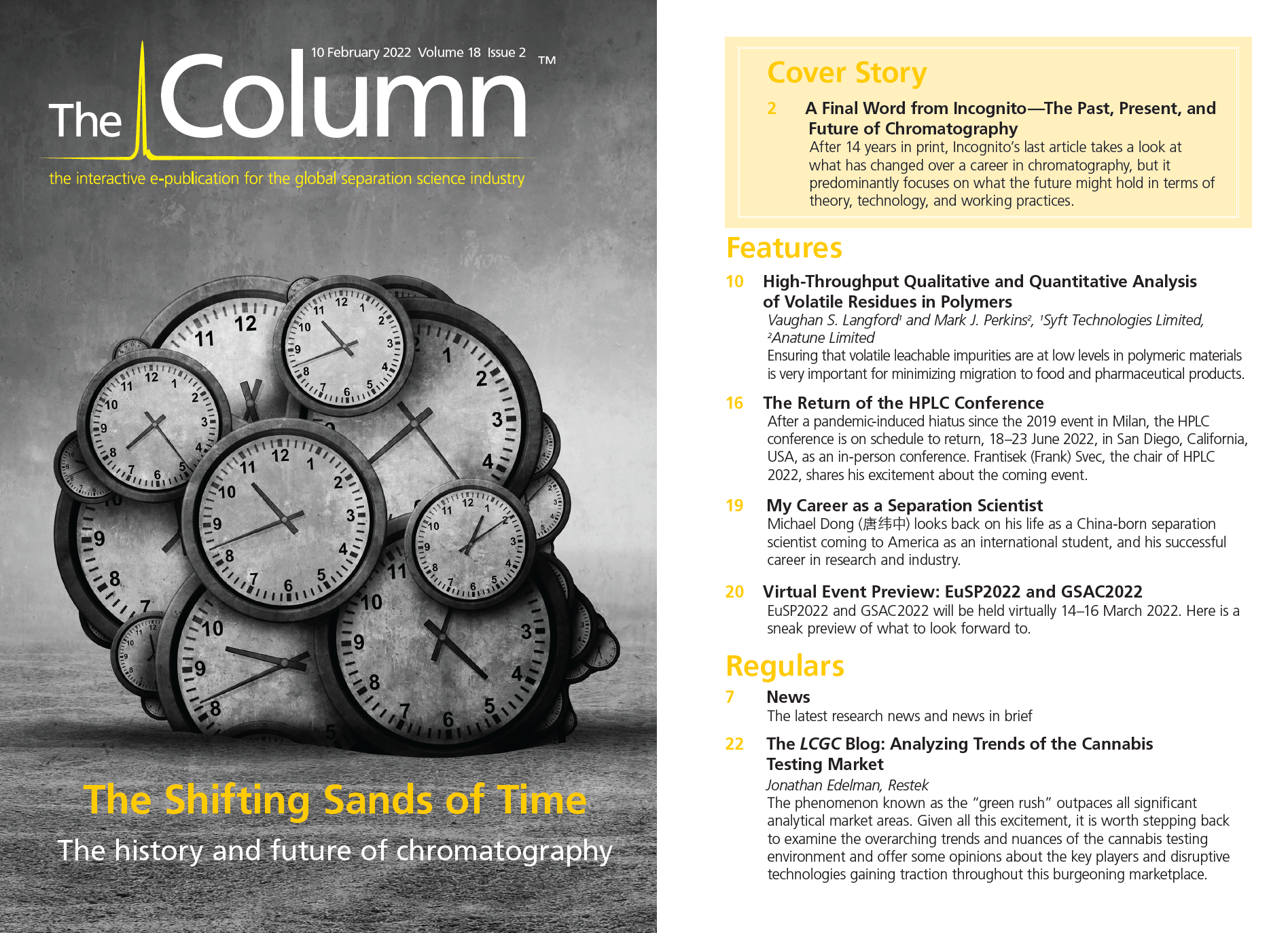High-Throughput Qualitative and Quantitative Analysis of Volatile Residues in Polymers
Ensuring that volatile leachable impurities are at low levels in polymeric materials is very important to minimize migration to food and pharmaceutical products. Sustainability initiatives have led to more recycled polymers being used by industry and therefore more frequent testing is required. Direct‑injection mass spectrometry (DIMS) techniques such as selected ion flow tube mass spectrometry (SIFT-MS) provide high throughputs at a low cost for each sample. This article reviews polymer analysis applications of automated headspace SIFT-MS. Rapid quality assurance/quality control (QA/QC) screening of approximately 250 samples a day was conducted using targeted or untargeted analysis, while quantitative volatile impurity analysis was achieved efficiently using multiple headspace extraction (MHE)-SIFT-MS.
Polymers are primarily synthesized by polymerization of low-molecular-weight organic compounds, and therefore monomer residues and other volatile byproducts can be trapped in the polymeric material. These volatiles then migrate through the polymer and transfer into adjacent materials (such as pharmaceuticals and consumer products, if the polymer is used as a packaging material). The reverse process can also occur, in that compounds—especially more volatile ones—can migrate from the contained product into the polymeric packaging. This, of course, is not an issue if the polymeric packaging is disposed of but may be an issue if it is being recycled. If the residual volatile does not wash out or otherwise migrate out during reforming into granules for the next use, then it may migrate into the next product. Hence, analysis of potentially toxic or taint‑causing volatile impurities is important for both virgin and recycled polymers. However, while impurities in virgin polymers are well characterized, recycled materials can vary markedly and therefore testing frequencies need to be increased.
Conventional volatiles analysis is conducted using gas chromatography (GC)-based techniques. These have the advantage of maximizing specificity by resolving volatile components temporally, but consequently result in a relatively low sample throughput. Further, analysis of very polar, low-molecular‑weight volatiles is often a significant challenge for GC, requiring derivatization and/or use of a specialized column. Direct-injection mass spectrometry (DIMS) techniques, which—through elimination of the chromatographic column—analyze samples continuously as they are introduced into the instrument, may provide the means by which higher sample throughputs can be achieved. Selected ion flow tube mass spectrometry (SIFT-MS) is a DIMS technique that has been demonstrated to be readily automated and adapted to routine analysis (1). In this article, applications of high-throughput SIFT-MS to quantitative and qualitative virgin and recycled polymers are reviewed, and the complementary relationship with GC methods emphasized.
Experimental
The SIFT-MS technique is described in detail elsewhere (2). Briefly, rapidly switchable reagent ions (H3O+, NO+, and O2+) were utilized for gas-phase soft chemical ionization of trace volatile organic compounds (VOCs) in air and headspace. Real-time, high-throughput analysis was achieved because SIFT‑MS is chromatography-free. Selectivity was achieved through the combination of multiple ionization mechanisms and mass spectrometric detection. A SIFT‑MS instrument was used in this work (Voice200ultra, Syft Technologies).
Automated headspace SIFT-MS analysis is best achieved using autosamplers based on syringe injection (1). In this work, automated headspace analysis was performed using a SIFT-MS instrument coupled with a multipurpose autosampler (MPS Robotic Pro, Gerstel). Details of analysis conditions are given in the cited literature. In general, headspace analysis was conducted using 20‑mL headspace vials, with sample extracted using a 2.5-mL headspace syringe, followed by steady injection (usually at a rate of 50 μL/s) into a flow of nitrogen makeup gas (around 10-fold dilution in the sample inlet).
High-Throughput Targeted Analysis
Targeted analysis is the preferred approach for volatiles that are likely to be present and are known to be toxic or have an odour impact. Because virgin polymers exhibit lower variation in their volatile impurities, they are usually more effectively screened using targeted SIFT-MS analysis than recycled polymers are. It should be noted that method development needs to ensure that the matrix is compatible with SIFT-MS so that false positive results are not reported for lower‑grade polymer products. These may produce elevated measurements for low-threshold target compounds if a target compound is interfered with by other volatile impurities.
Figure 1 demonstrates the flexibility of the SIFT-MS technique for targeted residual monomer analysis using three ground polymer samples incubated at 80 °C for 15 min (2.5 mL of headspace injected at 100 μL/s). Polystyrene (PS), polyoxymethylene (POM), and polyethylene terephthalate (PET) emit styrene, formaldehyde, and acetaldehyde, respectively. In contrast to chromatographic approaches, via highly controlled soft chemical ionization SIFT-MS can directly analyze routine VOCs, such as styrene, in the same run as low-molecular-weight aldehydes (that is, no sample preparation is required for formaldehyde or acetaldehyde). Figure 1 also shows that high sample throughputs are achievable with SIFT-MS. Incubated samples can typically be analyzed with a throughput of 12 samples an hour (or over 250 samples a day), meaning that SIFT-MS can provide rapid quality assurance/quality control (QA/QC) of polymers.

Quantitative Analysis of Volatile Impurities in the Polymer
Static headspace (SH)-SIFT-MS analysis of polymeric samples yields quantitative measurements of impurities in the headspace. However, relating this value to the mass of volatile in the polymer is very challenging because the nature of polymers means that preparation of standard, homogenous concentrations of impurities is not possible. Quantitative determination of speciated residual volatiles relies on the stripping of all volatiles using, for example, dynamic headspace analysis (DHA). Because exhaustive extraction using DHA is a very long procedure, Kolb and Ettre (3) developed the multiple headspace extraction (MHE) technique to achieve this from extrapolation of a limited number of headspace measurements that follow headspace purge and regeneration cycles.
Figure 2 shows MHE-SIFT-MS results obtained for styrene emitted from ground polystyrene pellets incubated at 140 °C for 60 min (4). Six replicates were analyzed, with each data point on the graph the mean across the replicates for that injection. Calculation of the area under the curve enabled the residual styrene concentration to be determined for each replicate. The mean concentration of styrene was 270 μg/g. The low relative standard deviation (RSD) of 1.4% demonstrates the excellent repeatability of SIFT-MS analysis.

MHE is a very protracted procedure when coupled with GC due to multiple analyses on the same sample. Direct headspace analysis in MHE-SIFT-MS means that significant efficiencies can be gained due to the much shorter analysis time: One sample can be analyzed while the headspace is generated in up to 11 other samples (4). The number of samples that can be analyzed in parallel is dependent on the time taken for the headspace analyze-and-purge cycle relative to the optimized headspace generation time (the time to reach equilibrium). For polystyrene, an eightfold throughput enhancement was achieved with SIFT-MS compared to the equivalent GC method.
Untargeted Analysis
Targeted SH-SIFT-MS and MHE-SIFT-MS methods work well for known volatile residues (especially in virgin polymer), but recycled plastics have varied usage histories and therefore have a substantially higher risk of releasing other, nontargeted compounds. In this scenario, with its potential for significant inter-sample variation, an untargeted SH-SIFT-MS approach is preferable. Nonconforming samples can be detected quickly by utilizing rapid full-scan SIFT-MS analysis with multivariate statistical data processing.
A recent study investigated variation in virgin and recycled high-density polyethylene (HDPE) pellets using this approach (5). Four virgin and 10 recycled samples (from six manufacturers) were obtained. Replicate samples (10 of 1 g each) were incubated at 80 °C for 20 min, then full-scan spectra were acquired with all three SIFT-MS reagent ions within one 40-s analysis. Figure 3 shows SIFT-MS full scan spectra obtained using the NO+ reagent ion for selected virgin and recycled HDPE samples (these are the mean of 10 replicates for each sample). Selected spectra span the range of variation observed in the sample set. Mass spectra of virgin HDPE samples generally have fewer spectral peaks and emit lower levels of volatiles than recycled HDPE samples (unless hydrocarbon residues are present). Recycled products exhibit a range of features derived from trace volatile impurities retained from prior use (despite washing).

Although a trained operator could potentially identify products visually, a more practical approach for industry utilizes classification by multivariate statistical analysis. Figure 4 summarizes the results obtained for the recycled products (S1 to S10) when the SIMCA (soft independent modelling by class analogy) algorithm (6) was applied to the data. All interclass distances had a value greater than three, indicating that the products were differentiated. These data are visualized on the class projection plot, while the discriminating power indicates the most significant variables (m/z here) that differentiate the products. Hence untargeted SIFT-MS analysis coupled with multivariate statistical analysis can be applied to rapid differentiation of recycled HDPE—for example, to assure pellet volatile emissions conform to the standard required for their intended use. It should be noted, however, that definitive identification is not a strength of DIMS techniques such as SIFT‑MS (outlier samples should be reanalyzed offline by GC–MS), whereas rapid and sensitive differentiation of products is.

Conclusion
Increased use of recycled plastic in consumer packaging means that wider testing of volatile residues is required. Automated SH‑SIFT‑MS has the potential to accommodate new analytical demands while also tackling existing analyses for volatile impurities in polymer because throughputs of greater than 250 samples per day are achieved. Moreover, SIFT-MS instruments can run targeted and untargeted analyses in a single sequence. Quantitative analyses of volatile residues in polymers are readily conducted using MHE-SIFT-MS, with an eightfold throughput enhancement for six‑injection MHE.
SIFT-MS also provides a unique breadth of analysis because of direct, soft chemical ionization of sample headspace, as exemplified by simple analysis of formaldehyde. SIFT-MS is complementary to chromatographic methods, providing high‑throughput qualification and quantitation, and broad VOC analysis, rather than detailed compound identification.
References
- M.J. Perkins and V.S. Langford, Rev. Sep. Sci. 3(2), e21003 (2021). doi: 10.17145/rss.21.003.
- D. Smith, M.J. McEwan, and P. Španel, Anal. Chem. 92, 12750–12762 (2020).
- B. Kolb and L.S. Ettre. Static Headspace-Gas Chromatography – Theory and Practice (2nd ed.) (John Wiley & Sons, New York, USA, 2006).
- M.J. Perkins and V.S. Langford, Rev. Sep. Sci. submitted for publication.
- V.S. Langford and M.J. Perkins, Rapid Comm. Mass Spec. in press. doi: 10.1002/rcm.9230.
- S. Wold, Pattern Recognit. 8, 127–139 (1976).
Vaughan Langford is a principal scientist at Syft Technologies in New Zealand. He joined Syft in late 2002 after completing his Ph.D. in physical chemistry at the University of Canterbury, and postdoctoral fellowships at the Universities of Geneva, Western Australia, and Canterbury. He has over 30 peer-reviewed publications on a wide range of SIFT-MS applications, plus he has contributed numerous conference papers.
Mark Perkins is a senior applications chemist and SIFT-MS expert at Anatune Limited, based in Cambridge, United Kingdom. Mark graduated from the University of Southampton, UK, with a Ph.D. in electrochemistry. He was with the Malaysian Rubber Board’s UK research centre for 12 years, first as a senior analyst, then as head of the analytical section. He joined Anatune in early 2015 in a role that supports and expands the analytical capability of SIFT-MS—with a particular focus on autosampler integration and the development of automated test methods.
E-mail: vaughan.langford@syft.com / mark.perkins@anatune.co.uk
Website: www.syft.com

Determining the Effects of ‘Quantitative Marinating’ on Crayfish Meat with HS-GC-IMS
April 30th 2025A novel method called quantitative marinating (QM) was developed to reduce industrial waste during the processing of crayfish meat, with the taste, flavor, and aroma of crayfish meat processed by various techniques investigated. Headspace-gas chromatography-ion mobility spectrometry (HS-GC-IMS) was used to determine volatile compounds of meat examined.
Accelerating Monoclonal Antibody Quality Control: The Role of LC–MS in Upstream Bioprocessing
This study highlights the promising potential of LC–MS as a powerful tool for mAb quality control within the context of upstream processing.

.png&w=3840&q=75)

.png&w=3840&q=75)



.png&w=3840&q=75)



.png&w=3840&q=75)















